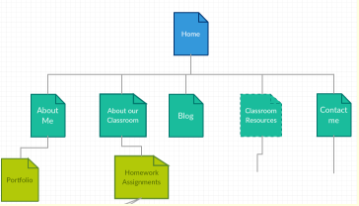Classroom Web Presence in the Cloud
All teachers have the ability to have a web presence. The application may be provided and mandated by the school district or the teacher may be able to make his/her own choices. The most important thing is to have a web presence and keep it updated with information and resources that will assist and complement the learning in your classroom. Your web presence will also be a valuable asset when blending/flipping your classroom.
Popular choices by teachers at this time are Google Classroom, Weebly, Moodle, Google Sites and Schoology. There are tutorials that can be found on the 21 Things 4 Students Web Presence Quest.
Do you have a web presence?
In this session you will either create a new website or blog or update your current one. There are four core areas to choose from:
- Learning Management Systems (LMS) or Content Management Systems (CMS) - These are usually managed through your school district.
- Moodle
- Blackboard
- Schoology
- Google Classroom
- Web Site Creators
- Blogs
- District Online Systems
Any of the above are appropriate to use for a web presence.
Steps:
1. If you already have a web presence, you may move on to Step four. If you do not have a web presence or want to learn something new, visit the 21 Things 4 Students Digital Footprint Thing.
2. Choose the resource that you think will enhance and complement your classroom.
3. Next, create a login and password and begin creating!
4. If you are creating or updating a website or blog, it is a good idea to first map out/brainstorm what the site is going to look like. Creating a website from scratch can be quite daunting and can become overwhelming without a plan. You can use the outline tool in Microsoft Word or here is a Creately Template where you can type in your ideas to get you started. Below is an example of what you might want to include on your site.

5. It is a good idea to start out small so that your website does not become overwhelming. You want to make sure to include the things that will benefit your students and their parents especially when you have a flipped or blended classroom. You also want to make sure that it is easy to update as needed.
Note: As you go through this unit you will be learning about various resources in the Cloud that you can create, locate and add to your web presence.
6. After you have created the basic shell of your site, share the URL with your instructor.
Note: Please do not spend more than 90 minutes on the creation of your site. It only needs to be the basic shell at this time.
Continue on to Content in the Cloud
Standards
Addressing the ISTE Standards For Educators
Learner
1a. Set professional learning goals to explore and apply pedagogical approaches made possible by technology and reflect on their effectiveness.
1c. Stay current with research that supports improved student learning outcomes, including findings from the learning sciences.
Leader
2b. Advocate for equitable access to educational technology, digital content and learning opportunities to meet the diverse needs of all students.
2c. Model for colleagues the identification, exploration,
evaluation, curation and adoption of
new digital resources and tools for learning.
Citizen
3a. Create experiences for learners to make positive, socially responsible contributions and exhibit empathetic behavior online that build relationships and community.
3c. Mentor students in safe, legal and ethical practices with digital tools and the protection of intellectual rights and property.
Designer
5a. Use technology to create, adapt and personalize learning experiences that foster independent learning and accommodate learner differences and needs.
Facilitator
6a. Foster a culture where students take ownership of their learning goals and outcomes in both independent and group settings.
6b. Manage the use of technology and student learning strategies in digital platforms, virtual environments, hands-on maker spaces or in the field.
6c. Create learning opportunities that challenge students to use a design process and computational thinking to innovate and solve problems.
6d. Model and nurture creativity and creative expression to communicate ideas, knowledge or connections.
Analyst
7a. Provide alternative ways for students to demonstrate competency and reflect on their learning using technology.
